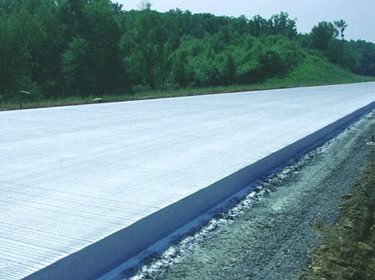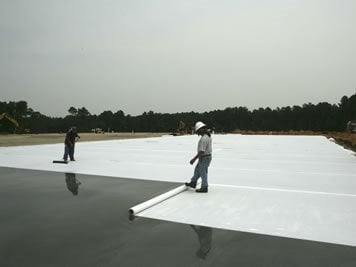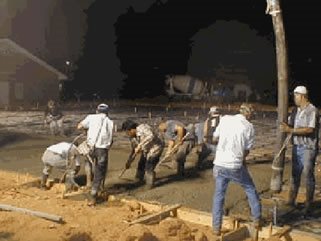- Pouring Concrete in Hot Weather
- Concrete Admixtures for Hot Weather
- Curing Concrete in Hot Weather
- Related Resources
- Pouring Concrete in Cold Weather
- Can You Pour Concrete in the Rain?
- Concrete Mix Design
- Types of Admixtures for Concrete
Section Sponsor

Packaged Admixtures
Seasonal Pouring Tips
Get guidelines for placing concrete by region and season throughout the U.S.
SELECT A REGION
Hot Weather Concrete Curing
How to cure concrete in hot weather using curing compounds or blankets
On plain gray concrete, a white pigmented curing compound can help reflect some heat from the sun.
Federal Highway Administration
Curing is critical any time, but especially in hot, dry weather and it needs to start as soon as your finishing operations are completed. With plain gray concrete, use a white pigmented curing compound that will help reflect sunshine. If you are using a curing blanket, use the white ones, either the single-use variety or the multiple use (Read more about curing concrete).
If you use a curing compound, make sure it is doing its job. Kozeliski advises running this test: "Put a 3-foot-square piece of plastic on the slab and put sand around the edges. Come back a little while later and if there's moisture under the plastic, the curing compound isn't doing the job. Often contractors get cracks and blame the concrete when actually it's that the curing compound didn't really work."

White curing blankets will help keep the concrete cooler by reflecting the sun. PNA Construction Technologies.
HOW TO DEAL WITH HOT WEATHER ON THE JOB SITE
If you start with concrete below 80°, then your objective is to keep it cool and to not let it dry out. In very hot weather, place the concrete early in the morning or later in the evening. Be prepared! Make sure your crew and all equipment are ready to go when the concrete arrives so you can get the concrete out of the truck-it can heat up a lot just sitting in the mixer waiting to be placed. Friction within the concrete during mixing can generate enough heat to raise the concrete temperature 5° in 30 minutes.
Learn more about Pouring Concrete in Hot Weather.
If slump loss becomes a problem, rather than adding excessive water, try using a superplasticizer (high-range water reducer). These admixtures can increase slump without affecting the concrete's final strength or appearance.
Learn more about Concrete Admixtures for Hot Weather.
 Mini Delayed Set
Good for step-delay concrete pouring
Mini Delayed Set
Good for step-delay concrete pouring
 Rescue-Pak
Contains six of our most effective admixtures
Rescue-Pak
Contains six of our most effective admixtures
 Standard Delayed Set
Dry Powdered Admixture
Standard Delayed Set
Dry Powdered Admixture
Keep the sun off the concrete surface if at all possible-for interior slabs, try to place after the building has been closed in; outside, use sun shades. Also keep all of your tools and equipment out of the sun, especially things like pump hoses that will come in direct contact with the concrete.
For exterior concrete, where you are placing on a subgrade, wet down everything, subgrade and forms, with cool water prior to placing the concrete so moisture isn't absorbed from the concrete, which can lead to cracking. "Wet the subgrade so that the moisture goes all the way through the 4 inches," says Kozeliski. "Too often the contractor only wets the top 1/16 inch and it sucks the water all out."
As soon as the concrete is down and bull floated, use a monomolecular film, or evaporation retarder. These materials evaporate after a couple of hours and have no negative impact on the concrete but will prevent the evaporation of surface water. Monomolecular film will prevent plastic shrinkage cracking and surface crusting.






